Myriade/AstroSat-100 (CNES Microsatellite Program)
EO
Atmosphere
High resolution optical imagers
CNES
Quick facts
Overview
| Mission type | EO |
| Agency | CNES |
| Mission status | Operational (extended) |
| Launch date | 29 Jun 2004 |
| Measurement domain | Atmosphere, Gravity and Magnetic Fields |
| Measurement category | Gravity, Magnetic and Geodynamic measurements, Atmospheric Winds, Lightning Detection |
| Instrument type | High resolution optical imagers, Other, Atmospheric chemistry, Communications, Data collection, Lightning sensors |
| CEOS EO Handbook | See Myriade/AstroSat-100 (CNES Microsatellite Program) summary |
Myriade/AstroSat-100 (CNES Microsatellite Program)
Myriade is the name of the CNES (French Space Agency) small satellite series. The Myriade initiative started with the Archacon scientific seminar held in 1998. It allowed to define a consistent panel of mission objectives, and permitted to offer to scientists the basis of a versatile tool for testing small payload instruments up to a mass of ~ 60 kg and to ~ 60 W of power, for short-duration missions (typically 2 years), with short development schedule and reduced costs. The development of the DEMETER and Parasol spacecraft. started in 1999. 1)
At the start of the 21 century the Myriade program represents the new microsatellite concept of CNES (France), taking advantage of low-cost satellites for technology demonstrations and to serve specific needs of the scientific community. The goal is to provide missions of about 15 MEuro (launch included) at a rate of two missions/year. In general, there are simply more frequent launch opportunities available for microsatellites as secondary payloads on a number of launch vehicles.
The objectives are to take advantage of these new enabling capabilities (innovation and introduction of technologies and common spacecraft structures, operations, management methods, building partnerships, improving access to space, etc.). Myriade offers the opportunity for a rearrangement of agency/industry functions such as to relieve CNES of the recurrent provisioning and integration tasks. It is also considered a structure for international cooperation (training for prime contractorship). The platform provides a large range of pointing capabilities: Earth pointing, inertial pointing. It also allows attitude slew maneuvers. 2) 3) 4) 5) 6) 7)
The original Myriade platform concept design was conducted by CNES. Today, the Myriade organization consists of:
• CNES is prime (design authority) of the Myriade series
• Satellite AIT (Assembly, Integration and Test) is performed by CNES or French industry. There is also a partnership between CNES, Thales Alenia Space (TAS, formerly Alcatel Alenia Space), and EADS/Astrium SAS.. Astrium has participated to system test bench development, software specification and validation, some of the AOCS modes development, etc. While Alcatel has participated to PCDU (Belgium) and system bench development.
• CNES signed partnership agreements with TAS, and EADS/Astrium SAS which permits them to use the Myriade bus design and products for their own applications/missions (defense, commercial market, etc.). 8) 9)
As of 2006, 16 Myriade-based satellites have been either launched (6 satellites) or are under development (10 satellites), see Table 2. The key for the success lies in the platform design were all elements have been carefully considered in terms of simplicity and robustness, while making no compromise with design and manufacturing quality. The most innovative initiative has been the decision to carefully review and minimize the redundancy principle, in association with a very efficient and well tested FDIR (Failure detection, Isolation and Recovery). A further key element in the program is the willingness of all partners to develop a real product line, i.e. carefully monitor the platform configuration, sign long term agreements with the equipment suppliers, make strategic stocks of elementary parts, etc.

Myriade Platform and Subsystems
The Myriade platform consists of a quasi cubic structure of 60 cm side length containing all subsystems. The overall architecture of the Myriade series S/C is based around generic avionics in support of the following functional chains: 10) 11)
• AOCS (Attitude and Orbit Control Subsystem). The system employs 3 coarse sun sensors (for acquisition and safe mode); a 3-axis magnetometer and a star tracker for precise attitude measurement; and three raw gyros (1-axis gyros) for attitude information during S/C maneuvers. Attitude control is provided by up to 4 reaction wheels and by magneto torquers (to unload the reaction wheels). An optional orbit control system (hydrazine propulsion with four 1 N thrusters) may be used for orbit maneuvering capabilities and/or 3-axis attitude control. A pointing performance of < 5º is provided in raw attitude control mode while the stellar sensor provides accuracies of better than 0.1º (3σ) with a knowledge of better than 0.02º.
• Power generation, regulation, and distribution function. This includes: a) one steerable AsGa solar array (two deployable panels), b) one 14 Ah lithium-ion battery, c) a PCDU (Power Conditioning and Distribution Unit) in charge of: S/C separation, battery regulation, power distribution, thrusters and magneto-actuator commands. The solar array may be fixed (sun-pointing mission) or oriented with a one-axis mechanism (normal to the orbit plane).
• The onboard control function is provided by an OBC (On-board Computer) based on a transputer T805 (with 1 Gbit memory) with FPGA and PIC microcontrollers for equipment interfaces (I2C bus). - The onboard software and its FDIR (Failure Detection, Isolation and Recovery) function have already successfully recovered many problems [SEU (Single Event Upset) on wheels, on star tracker, on DRAM memory].
• Thermal control is based on the use of passive systems (paints, MLI, SSM coatings) and heaters.
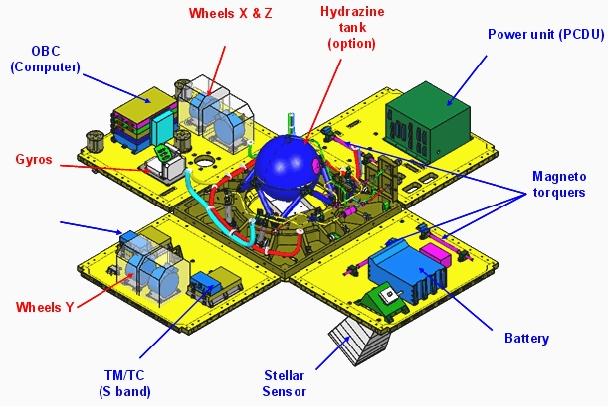
• Two S-band Rx/Tx chains and two antennas provide a quasi-omnidirectional coverage. The downlink data rate is 400kbit/s in operational modes and 25 kbit/s in safe mode. The S-band link is fully compliant with the CCSDS standard, whereas the X-band link complies with this standard at the packet level. The X-band is devoted to payload telemetry, whereas the S-band is being used for housekeeping and technological telemetry. The X-band downlink rates are in the range 18-72 Mbit/s. The S-band may be used for payload telemetry with limited data transmission requirements (up to 1 Gbit/day).
• The S/C design makes use of a generic and modular structure (aluminum and honeycomb). The X-panel includes the launcher adapter and the propulsion subsystem with its hydrazine tank. The payload is located on the X+ side of the bus. The mass budget of the series is < 130 kg. The power budget may be up to 200 W (max). The payload mass is limited to 40-60 kg, and a mean payload power of < 50 W. The design life is 2 years.
• Satellite redundancies are limited to :
- 2 transmitters (Tx) in cold redundancy
- 2 receivers (Rx) in hot redundancy
- 2 electric motors/electronics for solar generator rotating system
- Internal OBC parts (controllers, flash EPROM memories, DRAM memories for central software, FRAM memories).
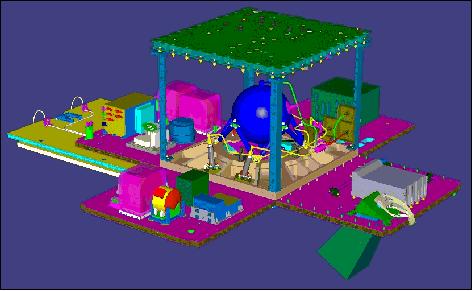
Operational Support Modes
Four AOCS operational modes have been developed (some modes might not be used):
• MAS (Mode Acquisition et Survie) or Acquisition and Safehold mode, which performs spacecraft solar pointing; it is used either for the first acquisition or the safe mode
• MGT (Mode Grossier de Transition) or Coarse Transition Mode, used to perform a coarse pointing support
• MCO (Mode Controle d'Orbite) or Orbit Control Mode, dedicated to orbit control maneuvers; it uses a set of thrusters
• MNO (Mode Normal Operational), used for fine attitude pointing (0.1º pointing performance); it is based on a star sensing measurements.
Some Lessons Learnt rom Operational Missions
• Based on Myriade platform design, 9 microsatellites are currently in flight: DEMETER, PARASOL, ESSAIM x 4, SPIRALE x 2, and Picard.(launch June 15, 2010) and more than about 10 others are under development. The oldest Myriade spacecraft is DEMETER, in-flight since 2004 and still operational in 2010 (6 years in orbit), knowing that it was originally designed for a 1 to 2 years mission. 12)
As Myriade was found an efficient tool on a large variety of satellite configurations and demonstrated it in-orbit capabilities, CNES has decided beginning of 2010 to carry on Myriade program, in partnership with Astrium SAS and TAS, and to engage the development study to a follow-up Myriade family for the next decade. The headlines of these development axes are the following ones:
- Since Myriade has proven its capability to withstand 3 to 5 years mission with a very good operation availability, its low cost approach particularly in terms of redundancy philosophy and COTS use would not be modified. Nevertheless, taking into account the in-flight REX (Return of Experience) and the new missions needs, CNES would like to reinforce the re-configuration possibilities, without adding more equipment and trying to keep the same overall cost. Taken into account the weak point pointed by the reliability analysis, an implementation of the 4 RWA (Reaction Wheel Assembly) in a pyramid configuration might indeed be a good investment.
- Due to equipment obsolescence of several components, like the T805 microprocessor which is the core part of the onboard computer, or the S-band emitter/receiver, the project has to come up with replacement solutions trying to avoid turning upside down everything around, including electrical and mechanical interfaces but also software issues. However, a microprocessor type change may imply a lot of other changes to adapt the low levels of the onboard control software, involving revalidations on ground and to develop new tests benches --- except if a new processor board can be implemented issued of a running R&D activity with an ASIC, which encapsulates the old microprocessor code, that may ease to carry the existing software on this hardware target.
- Looking to next missions foreseen to use Myriade bus, they will need more allowable mass and for sure a reinforced structure. After TARANIS (sprites and other electromagnetic phenomena study) and Microscope (verification of the equivalence principle) in phase B, MISTIGRI (monitoring of vegetation humidity level), MERLIN (CH4 measurement in atmosphere) or MICROCARB (CO2 measurement in atmosphere) which are missions studied in phase A, all exhibit a launch mass of 200 kg (a minisatellite by definition) for a payload mass reaching about 100 kg. - To improve the future satellite mass capacity of Myriade, an industrial contract will be started to redesign the platform structure (Ref 12).
• The choice of high-level performance for the Myriade platform was rather favorable for the program. Although COTS equipment is being used whenever suitable there is no compromise on overall quality. 13)
• AOCS: The pointing accuracies are better than 0.05º, due to good performances of the star tracker.
• The OBC has been developed internally at CNES with the support of an R&D program. The FDIR system was qualified on a test bench. The OBC provides a performance of 5 MIPS (1 Gbit memory) and is reprogrammable in orbit.
• The in flight operations (for all missions: DEMETER, PARASOL, Essaim and their payloads) have been completely successful so far (2009). The onboard software and its FDIR function have successfully recovered many problems (SEU impacts on wheels, on Star Tracker, on DRAM memory). The reloading function of onboard software has been used extensively to correct bugs or optimize functions or services. DEMETER has demonstrated very good autonomous orbit control function performance (satellite position maintained at ± 50 m wrt onboard commanding) thanks to efficient GPS and propulsion subsystem. (62 ms pulses generating a ΔV of < 1 cm/s).
• The aging of the solar generator and the battery induced losses of efficiencies in the range of 0.5 % to 8% after 15 months of in-flight operation.
• Some events (equipment resets due to SEU or software bugs/tunings), have induced satellite safe mode on the three in flight missions (around fifteen in total).
• There is a high probability of demonstrating in orbit a mission lifetime of > 3 years (design life of 2 years, the 2 years were already demonstrated as of August 2006).
As of 2006, the Myriade product line is considered to be operational. The design has been qualified in flight and the system can be used in many ways. As of fall 2006, there is a high probability that a demonstration of > 3 years in orbit operations will be achieved with the DEMETER mission (launch June 29, 2004) which surpassed already in August 2006 the design life of 2 years (Ref. 13).
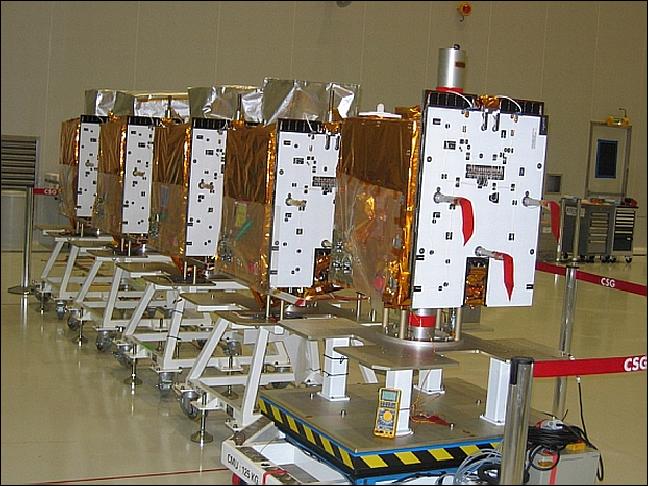
Subsystem | Component Manufacturer | Description/Performance |
Spacecraft structure | Al structure, honeycomb panels | - S/C: 600 x 600 x 800 mm, 130 kg total (with payload) |
Power | - Solar panels: TAS and Contraves | - 2 panels, 0.9 m2 total, rotating (200 W peak) |
AOCS | - Sun sensors (Astrium) | Demonstrated performances nominal mode: |
Localization/Orbit determination | - Performed by Control Center | By Doppler measurements : |
Onboard data management and command/control | - µprocessor T 805: CNES design (Steel manufacturing) | - 5 MIPS, 1 Gb memory (EDAC) |
RF communications, | - Tx link : CCSDS protocol and coding | - BER (Bit Rate Error): 10-10 |
Payload data downlink in X-band | Option : X band emitter for payload (Alcatel) | - 18 Mbit/s to 80 Mbit/s |
Payload management and data storage | Performed by payload electronic computer with microprocessor, solid state memory, (Steel) | 8, 16, 32 Gbit mass memory included in payload electronics |
Mission name | Launch | Description |
DEMETER (Detection of Electro-Magnetic Emissions Transmitted | June 29, 2004 | Science mission of CNES. Objective: detection and the characterization of electro magnetic waves signals associated with telluric activities (earthquakes, volcanic) or issued from human activities (power lines, VLF, HF broadcasting) |
PARASOL (Polarization and Anisotropy of Reflectances for Atmospheric Science coupled with Observations from a Lidar) | Dec. 18, 2004 | PARASOL is part of the NASA “A train”. It addresses climatology, in particular measurements of clouds and aerosols properties, and radiative budget interaction (contribution to the global warming) |
Essaim (`swarm' in French) | Dec. 18, 2004 | Constellation of 4 microsatellites of DGA (Defense Procurement Agency), France. The objective is analysis of the electromagnetic environment (military use). The satellites use the Myriade microsatellite bus of CNES. Development by EADS/Astrium SAS - along the lines of DEMETER but without a solar array drive mechanism. |
SPIRALE (Système Préparatoire InfraRouge pour ALErte) | Feb. 12, 2009 | A reconnaissance constellation of DGA with 2 satellites in GTO, S/C mass of 120 kg. Objective: early warning. Collection of infrared imagery of terrestrial backgrounds. Development by EADS/Astrium SAS and Thales Alenia Space /space segment). The French acronym of SPIRALE stands for:Preparatory System for IR Early Warning |
Picard | June 15, 2010 | CNES solar-terrestrial mission with French multi¿institutional and international cooperation. The overall objective is to monitor the solar diameter, the differential rotation, the solar constant, etc. Orbit: SSO of 700 km altitude at 18:00 hours. S/C mass of 150 kg. |
AlSAT-2A (Algeria Satellite-2A) | July 12, 2010 (planned launch of AlSat-2B in 2012) | An optical EO mission of CNTS (Algerian National Space Technology Centre). AlSAT-2 is being developed by EADS/Astrium SAS using the Myriade bus. Provision of imagery at GSD of 2.5 m (Pan) and 10 m in 4 MS bands. S/C mass of 130 kg, swath width of 17.5 km, design life of 5 years. The AlSAT-2 contract covers the design and development of two satellites. |
ELISA (Electronic Intelligence Satellite) | Dec. 17, 2011 | A constellation of 4 ELINT (Electronic Intelligence) S/C of DGA. Objective: demonstration of an operational mission. The ELISA S/C were developed by EADS/Astrium SAS and THALES as co-prime contractors. |
SSOT (Sistema Satelital para la Observación de la Tierra) | Dec. 17, 2011 | SSOT (Satellite for Earth Observation) is an optical high-resolution microsatellite imaging mission of ACE (Agencia Chilena del Espacio - Chilean Space Agency), Santiago, Chile. SSOT was developed by EADS Astrium SAS. It is based on a customized Myriade platform. Astrium refers to this platform version as Astrosat-100. In particular, SSOT is of AlSat-2A heritage (120 kg) and features the same payload as AlSat-2A, namely NAOMI (New AstroSat Optical Modular Instrument). |
SARAL / Altika (Altimeter Ka-band) mission | 2012 | SARAL (Satellite with ARgos and ALtiKa) is a cooperative altimetry technology mission of ISRO (Indian Space Research Organization) and CNES (Space Agency of France). In this setup, CNES is providing the payload module consisting of the AltiKa altimeter, DORIS, LRA, and Argos-3 DCS (Data Collection System), and the payload data reception and processing functions, while ISRO is responsible for the platform, launch, and operations of the spacecraft. Objective: study of the mesoscale oceanic variability (50/500 km wavelength, days/year period, amplitude < 30 cm), of he cost and land altimetry, of continental waters and ices, ), of the rain, and contributes to MERCATOR. Payload: 37.75 GHz altimeter (full deramp), with antenna, horn and electronic , a radiometer (24 and 37 GHz) for tropospheric correction, DORIS, and a laser retroreflector mirror. |
TARANIS (Tool for the Analysis of RAdiations from lightNIngs and Sprites) | 2015 (scheduled) | A cooperative mission of CEA (Atomic Energy Commission) of France and other labs in France and USA. The objective is to study of the mechanisms that generate upward lightning in the terrestrial atmosphere (observe coupling phenomena (sprites, particles) between upper atmosphere, ionosphere and magnetosphere during storms). The payload is constituted by electric and magnetic antennas, Langmuir probe, 2 cameras, photometer and X, g and electrons sensors. SSO of ~650 km, S/C mass of 130 kg. |
MICROSCOPE (MICRO-Satellite à traînée Compensée pour l'Observation du Principe d'Equivalence) | 2015 (planned) | CNES/ESA gravity¿research minisatellite mission, put forward by ONERA and Observatoire de la Côte d'Azur/Department GEMINI in Grasse, France, S/C mass of 190 kg. Objective: fundamental physics experiment to test the general theory of relativity. Orbit: SSO of 700 km altitude at 18:00 hours. |
SMESE (SMall Explorer For the study of Solar Eruptions) | Proposed | A combined UV-IR-X-ray and γ-ray solar mission is proposed by IAS and LECIA institutes (France), in cooperation with PMO (Purple Mountain Observatory) of China. This mission is dedicated to observation of solar flares and of coronal mass ejection from sun. |

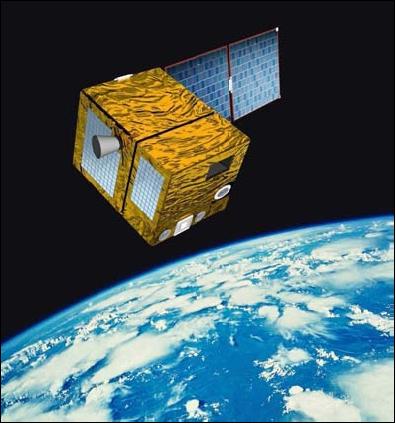
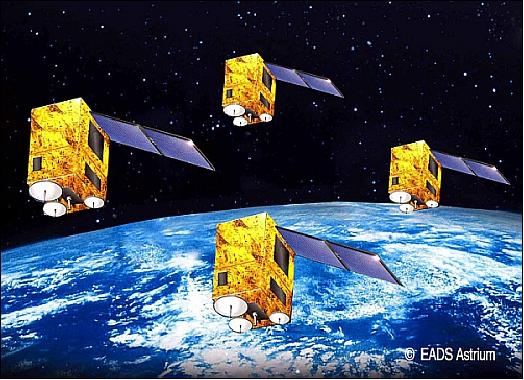




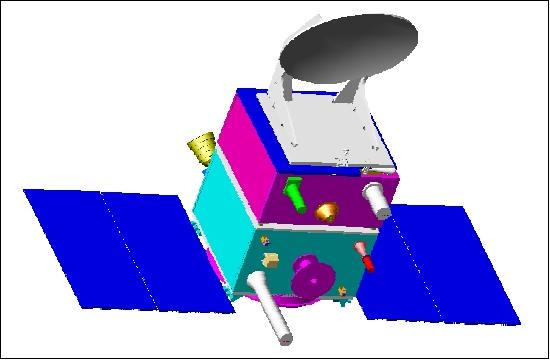
Note: In the timeframe 2005/6, the AltiKa instrument was planned to fly on a Myriade platform. However, on Feb. 23, 2007 CNES and ISRO signed a MOU (Memorandum of Understanding) of the cooperative SARAL (Satellite with ARgos and ALtiKa) mission in which ISRO became the provider of the spacecraft (AltiKa is provided by CNES).
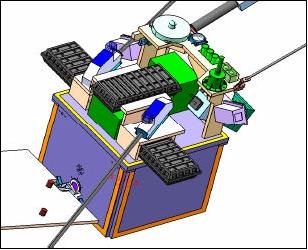
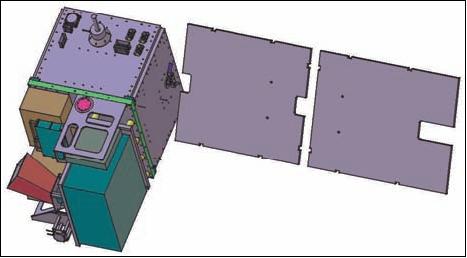
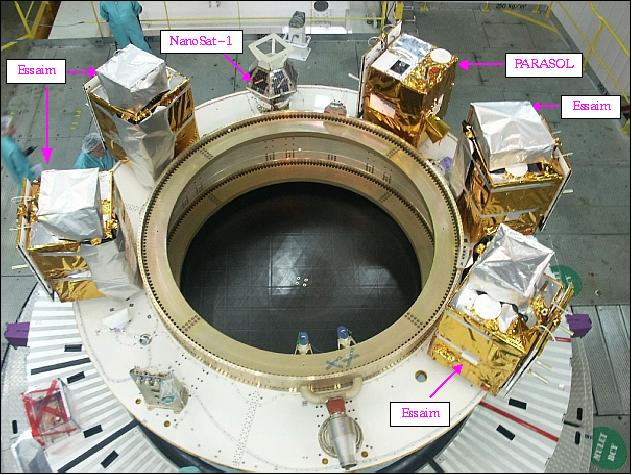
Myriade Ground Segment
The multi-mission Myriade ground segment consists of:
• CCC (Command and Control Center), located at CNES in Toulouse, France. It performs the monitoring function [TT&C (Telemetry, Tracking & Command)] for the various Myriade missions. CCC can operate up to five Myriade missions in parallel.
• A ground station network (with 3.1 m diameter antenna S-band stations in Toulouse and northern Europe, and an X-band station in Toulouse for payload data acquisition). The network operates automatically.
• Another CNES station network can be used for punctual tasks (e.g., localization, etc.).
• The CCC interfaces with the scientific (or technological) Mission Center which send the payload programming messages and receives the payload data.
References
1) Philippe Landiech, Paul Rodrigues, and all CNES mini and micro satellite teams, “Overview on CNES Microsatellite Missions: in flight, under development and next,” Proceedings of the 7th IAA Symposium on Small Satellites for Earth Observation, Berlin, Germany, May 4-7, 2009, IAA-B7-0102, URL of presentation: http://media.dlr.de:8080/erez4/erez?cmd=get&src=os/IAA/archiv7/Presentations/0102_IAA-B7-0102_Rodrigues.pdf
2) B. Tatry, M.-A. Clair, F. Buisson, “Small Satellites CNES Programme - Missions Flown and in Preparation, Lessons Learnt, Success Conditions,” Proceedings of the 20th Annual AIAA/USU Conference on Small Satellites, Logan, UT, Aug. 14-17, 2006, paper: SSC06-IV-2
3) Information provided by Bernard Tatry of CNES, Toulouse, France
4) J. P. Aguttes, “High Resolution (metric) SAR Microsatellite Based on the CNES Myriade bus,” Proceedings of IGARSS-2001, July 9-13, 2001, Sydney Australia
5) M. H. Thoby, “MYRIADE: CNES Microsatellite Program,” AIAA/USU Small Satellite Conference, Aug. 13-16, 2001, Logan, UT, SSC01-I-8
6) D. Alary, H. Lambert, “The Myriade Product Line, A Real Success Story,” Proceedings of the 57th IAC/IAF/IAA (International Astronautical Congress), Valencia, Spain, Oct. 2-6, 2006, IAC-06-B5.4.01, also in Acta Astronautica, Vol. 61, Issues 1-6, June-August 2007, pp. 223-227
7) Philippe Landiech & all CNES Mini and Macro Satellites Teams, “Overview on CNES Micro and Mini Satellites Missions: In Flight, Under Development and Next,” Proceedings of the IAA Symposium on Small Satellite Systems and Services (4S), Rhodes, Greece, May 26-30, 2008, ESA SP-660, August 2008
8) P. Luneau, M.-A. Clair, S. Pradalie, “MYriade CNES/Alcatel/Astrium Partnership,” Proceedings of the 4S Symposium: `Small Satellite Systems and Services,' Chia Laguna Sardinia, Italy, Sept. 25-29, 2006, ESA SP-618
9) B. Tatry, M.-A. Clair, “Myriade CNES Small Satellite Program - Performances, Missions, Tool for education and cooperation,” Proceedings of the 57th IAC/IAF/IAA (International Astronautical Congress), Valencia, Spain, Oct. 2-6, 2006, IAC-06-B5.1.01
10) M. Le Du, J. Maureau, P. Prieur, “Myriade: an adaptive AOCS concept,” 5th International ESA Conference on Guidance Navigation and Control Systems, Frascati, Italy, Oct. 22-25, 2002, ESA SP-516
11) http://smsc.cnes.fr/MYRIADE/GP_plateforme.htm
12) Ph. Guay, R. Laulheret, P. Rodrigues, “In-flight Experience of Myriade Family,” Proceedings of the Symposium on Small Satellite Systems and Services (4S), Funchal, Madeira, Portugal, May 31-June 4, 2010
13) B. Tatry, M.-A. Clair, “Myriade CNES Small Satellite Program: Performances, Missions, Tool foe education and cooperation,” Proceedings of the 57th IAC/IAF/IAA (International Astronautical Congress), Valencia, Spain, Oct. 2-6, 2006, IAC-06-B5.1.01